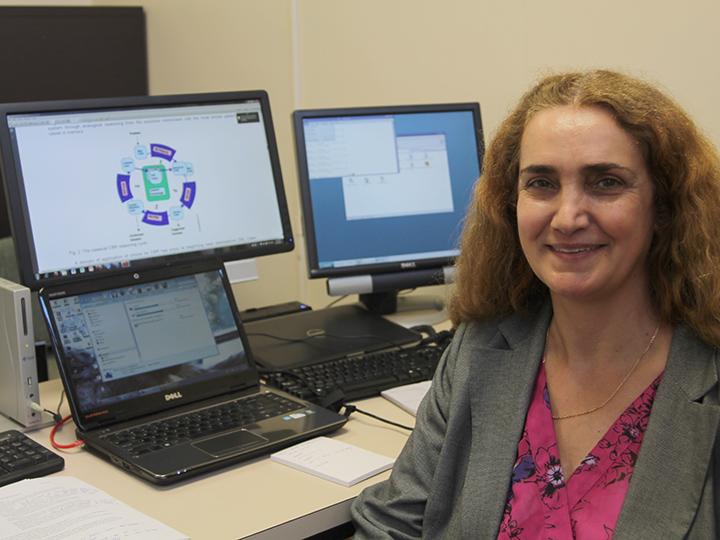Isabelle Bichindaritz of the college’s computer science department will teach the “Big Data, Genes and Medicine” course, Oswego’s pilot project in the evolving world of mass open online courses (MOOCs)
This fall, a new “Big Data, Genes and Medicine” course will represent Oswego’s pilot project in the evolving world of mass open online courses (MOOCs) while preparing learners for an in-demand job field.
Isabelle Bichindaritz of the college’s computer science department will teach the bioinformatics course, which supports an academic area that has a large unmet need at the intersection of health care, information technology and big data. The course will provide training in analyzing medical data and create e-portfolios that will document the skills of students.
The initiative will work with Coursera, an official partner with the SUNY system. Oswego was among the pioneers for the launch of the degree-oriented online learning platform Open SUNY in 2014 with its online MBA and MBA in health services administration programs. The college continues to look at new ways to deliver engaging, high-quality resources to motivated learners seeking these courses or content.
Bichindaritz started considering the possibility of teaching a MOOC after attending a conference while applying for an eventually successful SUNY Innovative Instructional Technology Grant (IITG). “Presenters discussed opening their own courses to people all around the world and the success they had,” she recalled. “The courses they were offering made them more available and well-known, worldwide.”
The IITG award proposed creating open educational resources (OERs)—teaching materials freely available to faculty and students anywhere—but conversations with Greg Ketcham, director of academic programs for Oswego’s Division of Extended Learning, led to discussions on creating a stronger bridge with a non-credit MOOC.
Oswego offers existing online graduate certificate programs in health information technology and integrated health systems, and has submitted a proposal to the state Education Department for a master’s program in biomedical and health informatics. SUNY Oswego also is creating a Biomedical and Health Informatics Research and Educational Lab, in collaboration with other SUNY partners and funded by a $1.4 million SUNY 2020 award.
“It’s a real educational opportunity,” said Bichindaritz, who has been leading the college’s efforts in the biomedical and health informatics area. “This is an academic field that needs advancement. It seems like the right time to do it, because I don’t believe many people are, and from my experience in the field, I see a need.”
Having a faculty-driven initiative in an expanding field made it an easy project to support, said Adrienne McCormick, dean of the College of Liberal Arts and Sciences. “We have significant expertise in biomedical and health informatics here, and collaborating with Coursera on this project raises awareness about our faculty and existing programs with a broader population of students,” McCormick said. “It helps raise awareness about the programs we have.”
Evolving education
While MOOCs originally appeared as a potentially disruptive force to education, the main providers are now working more on providing alternative means for learners to earn credentials that some employers recognize as evidence of specialized skills or knowledge, Ketcham explained.
“These companies are now building partnerships with flagship public schools and flagship public systems like SUNY,” Ketcham noted. “Coursera is already working with several schools across the SUNY system servicing job markets that need a larger number of educated or credentialed workers.”
While not meant to replace or replicate a traditional undergraduate or graduate experience, MOOCs can offer an alternative for people who find location a barrier.
Open educational resources and courses can help people as they seek career advancement, Bichindaritz said. “There are a lot of courses in data sciences but I believe in this specific application there is a need for knowing what is specific to the domains and application,” she said. “It’s a specialized field. The methods, problems and tools are specific.”
As an interdisciplinary field with potential students from many backgrounds, biomedical and health informatics is a good candidate for an open approach, Ketcham noted. “This course bridges the gap to raise the knowledge level across the board for those who want to work in this field,” he said.
In addition, having a successful course in the open-access system may serve as a gateway to make more people interested in Oswego’s educational offerings, Ketcham said.
McCormick credited Ketcham, Theresa Gilliard-Cook and others in the Division of Extended Learning for having the expertise to support development of a course that could find a broader non-traditional and online student base among people actively looking for these opportunities. “This shows our college embraces innovation and the opportunity to meet the grand challenges of our time,” she added.




